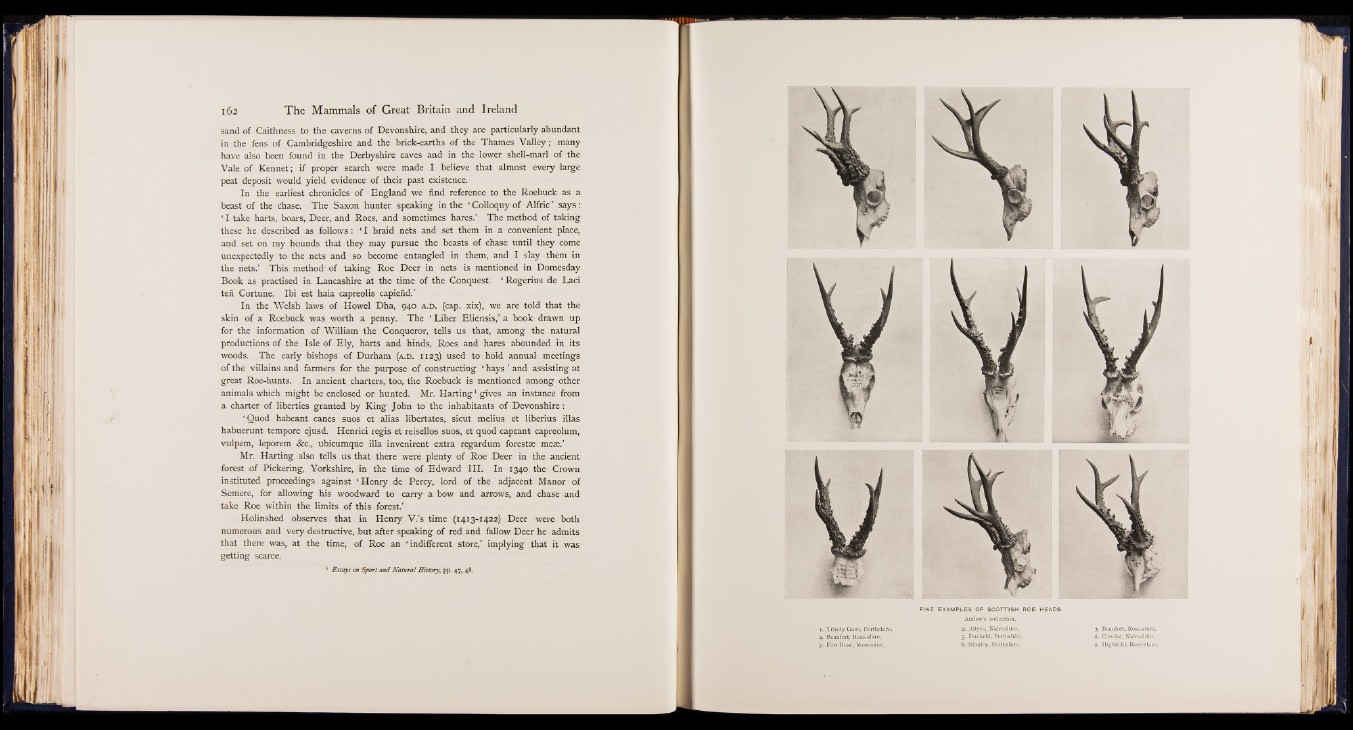
sand of Caithness to the caverns of Devonshire, and they are particularly abundant
in the fens of Cambridgeshire and the brick-earths of the Thames Valley; many
have also been found in the Derbyshire caves and in the lower shell-marl of the
Vale of Kennet; if proper search were made I believe that almost every large
peat deposit would yield evidence of their past existence.
In the earliest chronicles of England we find reference to the Roebuck as a
beast of the dhase. The Saxon hunter speaking in the ‘ Colloquy of Alfric | says :
‘ I take harts, boars, Deer, and Roes, and sometimes hares.’ The method of taking
these he described as follows: ‘ I braid nets and set them in a convenient place,
and set on my hounds that they may pursue the beasts of chase until they come
unexpectedly to the nets and so become entangled in them, and I slay them in
the nets.’ This method of taking Roe Deer in nets is mentioned in Domesday
Book as practised in Lancashire at the time of the Conquest. ‘ Rogerius de Laci
ten Cortune. Ibi est haia capreolis capiend.’
In the Welsh laws of Howel Dha, 940 a .d . (cap. xix), we are told that the
skin of a Roebuck was worth a penny. The ‘ Liber Eliensis,’ a book drawn up
for the information of William the Conqueror, tells us that, among the natural
productions of the Isle of Ely, harts and hinds, Roes and hares abounded in its
woods. The early bishops of Durham (a .d . 1123) used to hold annual meetings
of the villains and farmers for the purpose of constructing ‘ hays ’ and assisting at
great Roe-hunts. In ancient charters, too, the Roebuck is mentioned among other
animals which might be enclosed or hunted. Mr. Harting1 gives an instance from
a charter of liberties granted by King John to the inhabitants of Devonshire:
‘ Quod habeant canes suos et alias libertates, sicut melius et liberius illas
habuerunt tempore ejusd. Henrici regis et reisellos suos, et quod capeant capreolum,
vulpem, leporem &c., ubicumque ilia invenirent extra regardum forestae meae.’
Mr. Harting also tells us that there were plenty of Roe Deer in the ancient
forest of Pickering, Yorkshire, in the time of Edward III. In 1340 the Crown
instituted proceedings against ‘ Henry de Percy, lord of the adjacent Manor of
Semere, for allowing his woodward to carry a bow and arrows, and chase and
take Roe within the limits of this forest.’
Holinshed observes that in Henry V.’s time (1413-1422) Deer were both
numerous and very destructive, but after speaking of red and fallow Deer he admits
that there was, at the time, of Roe an ‘ indifferent store,’ implying that it was
getting scarce.
Essays on Sport and Natural History, pp. 47, 48.